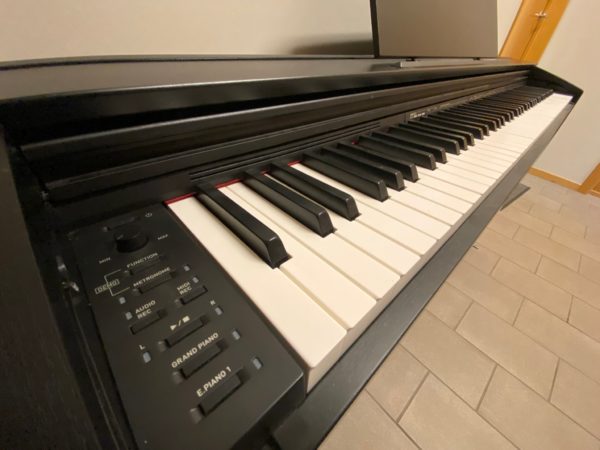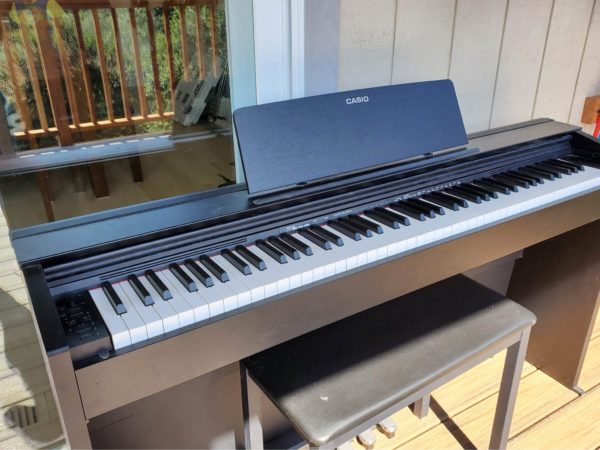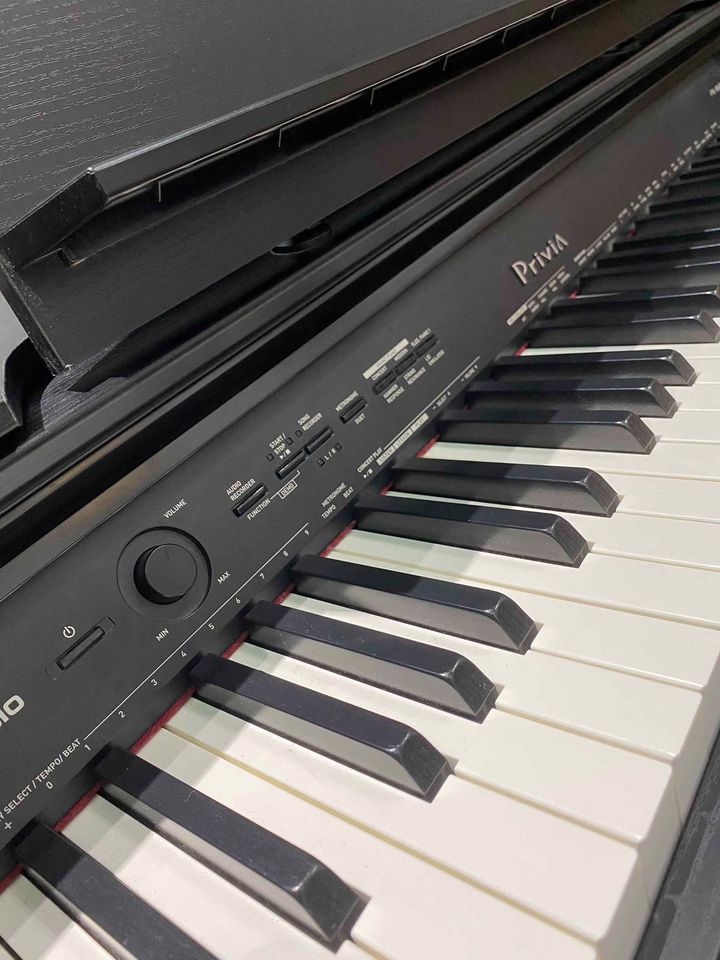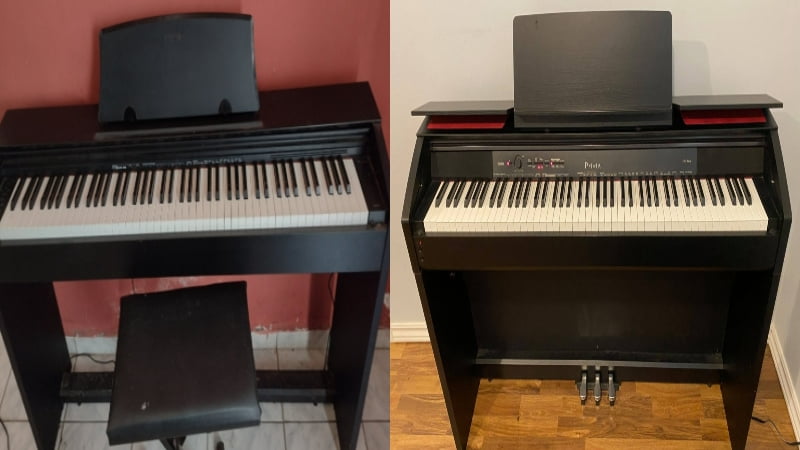When writing this Casio PX-870 vs 860 review, I found that the flagship PX-870 held up to its reputation, which is why it might just be the better option between the two.
If you’re on the hunt for a digital piano on a budget, there aren’t too many options that can beat the Casio Privia collection. These are affordable, high-quality, and feature packed pianos that can hold their own against more expensive models on the market.
And two pianos from the Privia collection that are often pitted against each other are the Casio PX-870 and the 860. When creating this Casio PX-870 vs 860 review and researching all the different features, I found that the Casio PX-870 is the better investment.
As the flagship model of the Privia line, the PX-870 comes with everything you need from a digital piano. It has a solid construction, great feel, and on top of all of that, is affordable.
The Casio PX-860 is a great digital piano for those on a budget, but as of now, it’s pretty hard to find. While it was originally the cheaper option between the two, since it can be very hard to find since the release of the PX-870, the Casio PX-860 is now pretty expensive when shopping from certain stores and shops.
Casio PX-870 vs 860: Comparison Chart




Last update on 2025-04-15 / Affiliate links / Images from Amazon Product Advertising API
Casio PX-870 vs 860: The Features
Between these two pianos, it was hard to find a winner. However, after comparing each of the features up head to head, I found that the Casio PX-870 has a slight edge with a score of 3-2. Both of these pianos were tied for most of the comparison since they offer similar features, but since the PX-870 is a bit more affordable and offers more versatility, it eventually won out.
Tone

The winner: Casio PX-870
The first point of comparison between these two pianos was tone. And since they share the same tone generator, the quality of the voices on both pianos is pretty similar. However, what sets them apart is the sound library. The Casio PX-870 has a slightly larger sound library for a, which gives it the edge over the PX-860 especially considering the price.
+Tone Generation
These are two great pianos from Casio. And one of Casio’s most famous features is the AiR Sound Source. This tone generator aims to replicate the way the acoustic piano’s sound waves travel through the air, making for a much more realistic tone.
At the heart of this tone engine are samples. Just like other pianos in the sub-$2,000 range, both the PX-870 and 860 use samples that you trigger whenever you press on a key. However, the difference with the AiR sound source is that it uses 4-layer samples for each sound.
That way, you get a more rounded tone that better reflects the sound of an acoustic piano. When conducting an ear test, I could barely tell the difference between these two pianos. But since they both use the AiR Sound Source, it wasn’t really a surprise.
+Sound Library
If these two pianos use the same tone generator, you might be wondering why I chose the PX-870 as the winner.
Firstly, the PX-870 is easier to find than the 860, so you don’t have to spend as much money to utilize this wide range of bright and vibrant voices. And on top of that, the PX-870 has 19 different voices while the PX-860 only has 18 voices.
With digital console pianos, you can’t expect hundreds of voices. Digital pianos focus on quality over quantity, so while you get a smaller selection of voices, you can rest assured that all the voices are top-quality.
On top of that, both of these pianos share a similar library. They both feature different voices such as piano, electric piano, organ, and even a selection of bass tones. This gives you a lot of variety when it comes to your sound, which is a huge plus for a lot of pianists.
With that said, the Casio PX-870 offers one additional voice compared to the 860. This comes in the form of the rock piano. This is a very bright piano perfect for playing rock and roll and even blues music.
And because of this extra voice, the Casio PX-870 ultimately won out in the tone comparison.
Feel

The winner: Tie
There was nothing separating these two in terms of feel, literally. Both of these pianos use the same hammer action system and even sport the same texture on the keys. And when testing these out, I found that they felt identical, which is why I couldn’t choose a winner in this category.
With that said, keep in mind that the Casio PX-870 is the more accessible model. So, you’ll be able to get the same piano feel as the Casio PX-860 while also saving a significant amount of money.
+Hammer Action
Both of these pianos use the Casio Scaled Hammer Action II system. This is a bit more sophisticated than the scaled hammer action system as the cheaper models, and is actually comparable to the Yamaha Graded Hammer Standard.
So, with these pianos, you can feel a slight difference in the weight of the lower and higher keys. Just like acoustic pianos, these two models have slightly heavier keys on the low end compared to the high end. This makes it easier for pianists to switch between digital and acoustic pianos without having to worry too much about adjusting their touch.
On top of that, the pianos both have adjustable touch sensitivity. So, if you find that your touch is heavier or lighter than usual, you can make small sensitivity adjustments to better suit your playing style.
+Key Texture
In terms of key texture, these two pianos go above and beyond. When shopping in the sub-$2000 range of digital pianos, you usually have to deal with glossy plastic keys. While these are the cheaper option compared to real wooden keys, they feel very different from an acoustic piano, which can get in the way of the realism.
But on the Casio PX-870 and the 860, you get textured plastic keys. While they are still not as good as real wooden keys, they feel much more realistic than uncoated glossy plastic keys. The coating on the Casio PX-870 and 860’s keys are designed to replicate the texture of ebony and ivory keys, and while they aren’t perfect, they do a fairly good job at providing pianists with a realistic piano feel.
Piano Features

The winner: Tie
Another area wherein these features are tied are the piano features. Both of these pianos come with the same playing modes and effects, which isn’t unexpected considering they’re in the same product line.
+Playing Modes
On both the Casio PX-870 and 860, you can experiment with layer, lesson, and split modes. If you’re a beginner, the lesson mode is arguably the most important of these features. With lesson mode on, the piano is split into two different zones with the same voice and tuning. That way, you and your teacher can play alongside each other and play the exact same piece without crossing over.
This is very beneficial when trying to learn and pick up new techniques or if you need a guide to play along with you.
Layering and split modes are more suited for performances. With layering mode, you can combine two voices. With split mode, you can assign a different voice to each side of the piano, making it seem like you’re playing two instruments at once.
However, keep in mind that the bass voices won’t work with these modes, which can be fairly limiting.
+Effects
When it comes down to effects, these two pianos are almost identical. They both have chorus and reverb effects with different presets. On top of that, they also share a variety of more passive effects such as brilliance. While most beginners won’t use ambience and brilliance, it does allow you to have more control over your tone.
With that said, the advantage of the Casio PX-860 is that it has DSP built-in to some tones. And while this is a great feature, it wasn’t enough to declare it the winner in this category, especially when you consider the price difference between the two pianos.
Casio PX-870 vs 860: The Similarities
These two pianos are very similar, which is why they are commonly compared to each other. While the Casio PX-860 is harder to find, it comes with about the same features as the PX-870, which is why I found the PX-870 to have more value.
As mentioned earlier in the comparison, both of these models share the same tone generator, hammer action system, key texture, and even piano features. So, you won’t go wrong choosing any of these two pianos, whether you’re a beginner or an experienced musician.
However, since the Casio PX-870 offers a bit more versatility at a budget price point, it might be more worth your money. There’s nothing wrong with the PX-860, but if you’re looking for a true bang for your buck, you might want to consider the Casio PX-870.
Quick Rundown of the Casio PX-870
- The AiR engine provides highly-accurate grand piano sounds with seamless dynamics for a remarkably expressive and powerful performance
- The PX-870 features a variety of 19 instrument Tones, with the ability to layer and split them as needed. Touch Response - 3 sensitivity levels, Off
- With a generous 256 notes of polyphony, you can rest assured that even the most complex performances will sound perfectly natural
- The Tri-Sensor Scaled Hammer Action II keyboard has an incredible feel and captures the dynamics of a performance with unparalleled speed and accuracy
- The powerful 40-watt, 4-speaker system is designed to envelop the listener, audience and room with rich, detailed sound
Last update on 2025-04-15 / Affiliate links / Images from Amazon Product Advertising API
Quick Rundown of the Casio PX-860
- Keys: 88 Ebony and Ivory feel
- Keyboard - Action: Tri-sensor Scaled Hammer Action Keyboard II
- Keyboard - Touch Response: 3 sensitivity levels, off
- Keyboard - Key Off Simulator: Yes
- Sound - Source: Multi Dimensional Morphing AiR
Last update on 2025-04-15 / Affiliate links / Images from Amazon Product Advertising API
Product Videos
Related Articles to Casio Px 870
- Casio PX-870 vs PX-850: Finding the Best Privia Piano
- Casio PX-870 vs AP-470: What Makes the AP-470 Different?
- Casio PX-870 vs Casio AP-650: Which Casio Should You Get?
- Casio PX-870 Vs AP-270: Which Console Digital Piano Should You Get?
- Casio PX-870 Vs Yamaha YDP-163: Which Digital Piano Is The Better Option?
- Casio PX-870 Vs Yamaha YDP-143: A Look At Two Top Digital Console Pianos
- Casio PX-870 Vs Yamaha P-125: Should You Get A Portable Or Console Digital Piano?
- Casio PX-870 Vs Kawai KDP-110: The Best Digital Pianos In The Price Range?
- Casio PX-870 Vs Roland F140R: Which Is The Better Piano?
- Casio PX-870 Vs Roland FP-30: Which Piano Should You Choose?
- Casio PX-870 Vs Roland RP102: Which Is The Better Console Digital Piano For Beginners?
- Casio PX-870 Vs PX-780: Which Casio Model Is Best For You?
- Casio PX-870 Vs Yamaha YDP-164: Which Is The Better Choice For Beginners?
- Casio PX-870 Vs Yamaha YDP-144: Which Is The Better Console Digital Piano?
- Casio PX-770 Vs 870: Which Casio Console Digital Piano Is Better?
Related Articles to Casio Px 860
References:
- Casio PX-870: https://www.casio-intl.com/asia/en/emi/products/px870/spec/
- Casio PX-860: https://pianoopedia.com/casio-px-860-review/
Lulacruza is an electronic folk duo operating at the junction of the hypermodern and the ancient. Our music weaves together hypnotic female singing, South American folk instruments and electronic processing, while channeling pulsating waves from the source of creation.
Lalucruza is also a community where you can connect with other music lovers to collaborate, exchange ideas and share knowledge. A platform for who wants to learns the basics of playing piano, guitar, drum masters’ technique, etc.. is the premise of our website.
